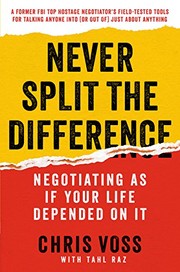
Never Split the difference
Author : Chris Voss
A guide to negotiation. Written by a hostage negotiator, so it's gotta be right, right?
ISBN : 9780062407801
Personal Rating : 9.2
Notes
- → Core Idea
- • Written by former FBI hostage negotiator Chris Voss.
- • Argues that negotiation is not about logic or compromise, but about emotional intelligence, empathy, and tactical communication.
- • “Never split the difference” means: don’t settle halfway — aim for outcomes that truly satisfy your goals.
- → Key Principles & Techniques
- 1. Mirroring
- • Repeat the last few words your counterpart says (in a calm tone).
- • Builds rapport and encourages them to elaborate.
- • Example:
- ⇾ Them: “I’m not sure this will work.”
- ⇾ You: “Not sure this will work?”
- Basically, be a broken record
- 2. Labeling
- • Identify and name the other person’s emotions to diffuse tension.
- • Use phrases like “It seems like…”, “It looks like…”, “It sounds like…”.
- • Example: “It seems like you’re frustrated with the process.”
- 3. Tactical Empathy
- • Understand and verbalize what the other side feels and sees.
- • Makes people feel heard — and once they feel understood, they become more flexible.
- 4. The Power of “No”
- • Encourage the other person to say no, because it makes them feel safe and in control.
- • “No” opens real discussion; “Yes” is often fake or forced.
- • Example: “Would it be ridiculous to consider…?” invites a safe “No.”
- Here, you can combine this with labeling. Exaggerate the situation so much that the opponent says no. Force a no.
- 5. Calibrated (Open-Ended) Questions
- • Ask “How” and “What” questions to shift problem-solving to them.
- • Example:
- ⇾ “How am I supposed to do that?”
- ⇾ “What would it take to make this work for you?”
- • This invites collaboration instead of confrontation.
- 6. The “Ackerman Model” (Bargaining Framework)
- 1. Set your target price (goal).
- 2. Start at 65% of that number.
- 3. Increase to 85%, then 95%, then 100%, using empathy and calibrated questions.
- 4. End with a non-monetary item to show you’re at your limit.
- 7. The 7-38-55 Rule of Communication
- • Only 7% of meaning is in words; 38% in tone; 55% in body language.
- • Emotional delivery matters more than exact wording.
- 8. “That’s Right” Moment
- • Your goal is to get the other person to say “That’s right”, not “You’re right.”
- • “That’s right” shows genuine agreement and understanding.
- 9. The “Black Swan” Concept
- • Look for hidden pieces of information (“Black Swans”) that can change the whole negotiation.
- • Every negotiation has unknowns — discovering them gives you leverage.
- → Mindset Shifts
- Negotiation is not war, it’s discovery.
- Empathy is not weakness; it’s a powerful tool.
- Patience and listening are more effective than pushing.
- Never compromise just to “meet in the middle” — that often means both sides lose.
- → Key Takeaways
- Good negotiators create trust through empathy, not dominance.
- Use tone, curiosity, and emotional intelligence to influence outcomes.
- The best deals come from connection, not competition.
No comments yet! be the first to comment!